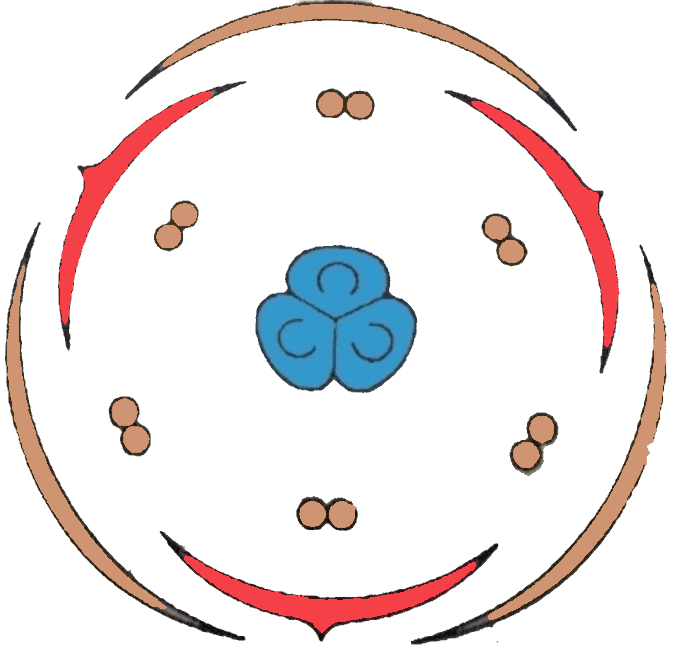
Which of the following has trimerous symmetric flowers?
a. Cactus
b. Lily
c. Fern
d. Cycas
Answer
580.2k+ views
Hint: A flower is symmetrical when each whorl consists of an equal number of parts or when the parts of anyone whorl are multiples of that preceding it. In trimerous symmetry, there is an arrangement in flower parts such as petals, sepals, and stamens, in sets of three.
Complete answer:
- Floral symmetry describes if and how a flower, in particular its perianth, can be divided into two or more identical or mirror-image parts.
- Monocotyledon plants are said to have trimerous symmetry.
- Lily belongs to the family Liliaceae. Lily is considered as an actinomorphic flower.
- Lily has a trimerous flower which means that it has six petals, six stamens, and six carpels.
- All lily flowers are symmetrical but the petals come in different shapes, and also differ in the hybrid division. Some lilies have reflexed petals, each petal curves backward.

In the diagram showing above we can see that the flower is having three similar segments or parts. The set of petals, sepals, and stamens are three.
Hence, The correct answer is option (B).
Additional information:
Flowers can be zygomorphic or actinomorphic based on their symmetry. Zygomorphic flowers are those which are divided into two equal planes whereas, in Actinomorphic flowers, flowers are dissected into two mirror images, even dissected from any plane.
Lily is a trimerous, actinomorphic, polyandrous, superior ovary, and axile placentation.
A cacti plant does not have trimerous symmetry. Plants of fern and cycad do not bear flowers, hence no trimerous symmetry.
Note: Trimerous symmetry is found in Monocots. Lily is a monocotyledonous plant characterized by parallel leaf venation, leaves are linear in shape, single or arranged in a rosette. Flowers can be distinguished based on other types of symmetry, namely radial symmetry, bilateral symmetry, and asymmetrical.
Complete answer:
- Floral symmetry describes if and how a flower, in particular its perianth, can be divided into two or more identical or mirror-image parts.
- Monocotyledon plants are said to have trimerous symmetry.
- Lily belongs to the family Liliaceae. Lily is considered as an actinomorphic flower.
- Lily has a trimerous flower which means that it has six petals, six stamens, and six carpels.
- All lily flowers are symmetrical but the petals come in different shapes, and also differ in the hybrid division. Some lilies have reflexed petals, each petal curves backward.

In the diagram showing above we can see that the flower is having three similar segments or parts. The set of petals, sepals, and stamens are three.
Hence, The correct answer is option (B).
Additional information:
Flowers can be zygomorphic or actinomorphic based on their symmetry. Zygomorphic flowers are those which are divided into two equal planes whereas, in Actinomorphic flowers, flowers are dissected into two mirror images, even dissected from any plane.
Lily is a trimerous, actinomorphic, polyandrous, superior ovary, and axile placentation.
A cacti plant does not have trimerous symmetry. Plants of fern and cycad do not bear flowers, hence no trimerous symmetry.
Note: Trimerous symmetry is found in Monocots. Lily is a monocotyledonous plant characterized by parallel leaf venation, leaves are linear in shape, single or arranged in a rosette. Flowers can be distinguished based on other types of symmetry, namely radial symmetry, bilateral symmetry, and asymmetrical.
Recently Updated Pages
Master Class 11 Economics: Engaging Questions & Answers for Success

Master Class 11 English: Engaging Questions & Answers for Success

Master Class 11 Social Science: Engaging Questions & Answers for Success

Master Class 11 Biology: Engaging Questions & Answers for Success

Class 11 Question and Answer - Your Ultimate Solutions Guide

Master Class 11 Business Studies: Engaging Questions & Answers for Success

Trending doubts
What is meant by exothermic and endothermic reactions class 11 chemistry CBSE

10 examples of friction in our daily life

One Metric ton is equal to kg A 10000 B 1000 C 100 class 11 physics CBSE

Difference Between Prokaryotic Cells and Eukaryotic Cells

What are Quantum numbers Explain the quantum number class 11 chemistry CBSE

1 Quintal is equal to a 110 kg b 10 kg c 100kg d 1000 class 11 physics CBSE




